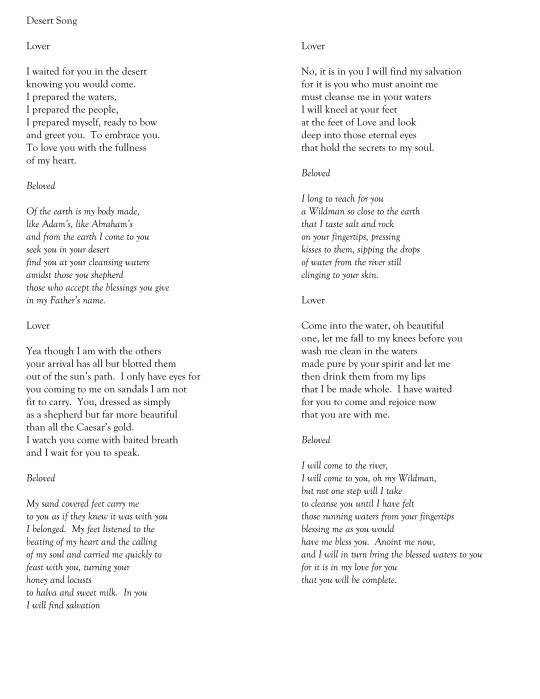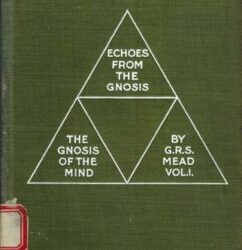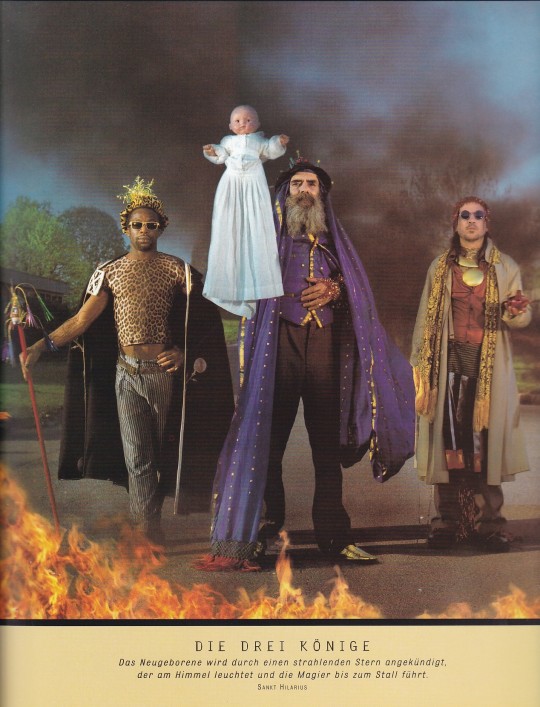#Jesus x John the Baptist
Text
Slashy Jesus/John the Baptist Poem
So, @one-coming-is-enough! I see you've been reblogging a ton of You/Judas slashy art. I want to offer up a poem that one of my most devout followers, @mischief-and-tea-by-the-sea, wrote years ago for a Bible as Lit class that wound up in their poetry thesis manuscript for grad school. It's in the style of Rumi and Song of Songs, if you will, and I think you'll like it. It's you and John the Baptist. I think you'll dig.


#good omens rp#a wild Loki appears#mischief-and-tea-by-the-sea#poetry#poem#Rumi#Song of Songs#Song of Solomon#slashy#Jesus#John the Baptist#Jesus x John the Baptist
24 notes
·
View notes
Text
I’ve watched “Godspell”. If you know at least a little how much I enjoy all those Bible reinterpretations, like “Jesus Christ Superstar”, “The Prince of Egypt” and so on you would easily guess how much I enjoyed it. Which is a lot. I mean – it’s simply a retelling of Gospel from Mathew, but in the weird urbanistic atmosphere, by a bunch of people dressed up like they are in cheat circus and, of course, with songs and dances. It was very lovely. Jesus is such a sweetheart – with those wheaten curls and sudden smiles. I still like Glen Carter better, but Victor Garber is also very good. Some scenes were pretty amusing, but some made me cry. You can again easily guess which: (spoilers to Bible?) the betrayal, of course. Generally, Jesus-Judas dynamics were very interesting to observe. The thing that Jesus kissed him first was really unexpected (I’m trying not to talk about the pairing so badly and I won’t talk about it, but you should know, that I’m thinking of it). The moment which made me feel so sorry was the “put that cup away from me” and
Jesus: Stay awake with me!
Everybody: I will stay awake!
And then they didn’t.
So, as a movie and Bible replay it was very good and interesting, as a musical just fine, nothing actually caught my ear.
P.S. I was a little confused at the beginning because John The Baptist and Judas Iscariot are like… the same person here, so when I first saw him I tried pretty hard to realize who’s that until I found out it’s both of them at the same time.
















#movie#musical#godspell#movie musical#Jesus Christ#judas iscariot#john the baptist#Bible#Gospel from Mathew#victor garber#david haskell#jesus x judas#yes I just tagged it like that
18 notes
·
View notes
Text
References in Servamp
Arabian mythology
Jinn. Ch. 16
Greek mythology
Elpis. Ch. 75
Moirai. Ch. 108
Pandora. Ch. 130
Pygmalion. Ch. 123
Pandora's Box. Ch. 97
Japanese mythology
Gashadokuro. Ch. 129
Kitsune. Ch. 3
Raijin. Ch. 85
Norse mythology
Baldr. Ch. 39
Freya. Ch. 65
Frey. Ch. 131
Gleipnir. Ch. 101
Hati. Ch. 91, 131
Hod. Ch. 39
Hliðskjálf. Ch. 96
Idunn. Ch. 65
Loki. Ch. 15
Mimir. Ch. 29
Mjölnir. Ch. 53
Ragnarök. Ch. 101, 122, 131
Sigurd. Ch. 101
Thor. Ch. 41
Yggdrasil. Ch. 42
Biblical references
Abel. Ch. 8
Adam. Ch. 128
Boaz and Jachin. Ch. 42
Eden. Ch. 21
Eve. Ch. 1
John the Baptist. Ch.122
Lucifer. Ch. 135
Nod. Ch. 29, events
Hinduism
Asura. Ch. 57.5, 89.
Tarot
The Fool - Mahiru. Ch. 50
I. The Magician – Night trio. Ch. 41
II. The High Priestess – Mikuni. Ch. 42
V. The Hierophant - Shuhei. Ch. 77
X. Wheel of Fortune - Junichiro. Ch. 53
XII. The Hanged Man - Tsurugi. Ch. 50
XV. The Devil – Shamrock. Ch. 72
XVI. The Tower - Touma. Ch. 47
XVII. The Star - Iduna. Ch. 73
XVIII. The Moon - Yumikage. Ch. 69
Literary references
"Alice's Adventures in Wonderland" Lewis Carroll. Ch. 3, 4, 7, 19, 98, 122. Misono, Lily, Dodo, Mitsuki, Yamane, Hattori, Mikuni, Bad B and Good B.
"As You Like It" William Shakespeare. Ch. 10, 38.5. Mikuni's spell.
"My Fair Lady" English nursery rhyme. Ch. 10 Mikuni's spell.
"Dracula" Bram Stoker. Ch. 12, 30. Hugh.
"Romeo and Juliet" William Shakespeare. Ch. 23, 34. Hyde, Ophelia.
"Faust" by Johann Wolfgang von Goethe. Ch. 29 Johannes.
"Through the Looking-Glass" Lewis Carroll. Ch. 29, events. Mikuni, Johannes.
"Julius Caesar" William Shakespeare. Ch. 23 Hyde.
"Strange Case of Dr. Jekyll and Mr. Hyde" Robert Stevenson. Ch. 23, 37. Hyde, Licht.
"Macbeth" William Shakespeare. Ch. 24, 31. Kuro, Saint Germain, Mahiru.
"Night on the Galactic Railroad" Kenji Miyazawa. Ch. 26. Higan.
"The Little Prince" Antoine de Saint-Exupéry. Ch 30, 67. Kuro, Mahiru, Sloth demon, Gear, probably Jeje.
"Hamlet" William Shakespeare. Ch. 33, 34. Hyde, Ophelia.
"The Phantom of the Opera" Gaston Leroux. Ch. 36 Licht and Hyde technique.
"Peter and Wendy" James Barry. Ch. 44, 56, 74. Tsurugi, Touma, Mahiru.
"Ring a Ring o' Roses" nursery rhyme. Ch. 53 Junichiro's spell.
“Peter Pan in Kensington Gardens” James Barry. Ch. 53, 75. Tsurugi, Touma.
"Death in Venice" Thomas Mann. Ch. 55 Gilbert technique.
"Total Eclipse" a play by Christopher Hampton. Ch. 55 Rayscent's technique.
"The Morning of the Last Farewell" Kenji Miyazawa. Ch. 57.5 Tsubaki.
"Spring and Asura" Kenji Miyazawa. Ch. 57.5 Tsubaki.
"The Catcher in the Rye" Jerome Salinger. Ch. 62 Shuhei.
"Four and Twenty Blackbirds" Agatha Christie. Ch. 62 Shuhei's spell.
"Metamorphosis" Franz Kafka. Ch. 62 Shamrock technique.
“The Nighhawk's Star” Kenji Miyazawa. Ch. 62, 76. Shamrock technique.
"Rock-a-bye Baby" an English lullaby. Ch. 70 Touma's spell.
“Schlafe, mein Prinzchen, schlaf ein” lullaby. Ch. 70 Touma's spell.
"Who Killed Cock Robin" an English nursery rhyme. Ch. 70 Yumikage's spell.
"The Wonderful Wizard of Oz" Lyman Frank Baum. Ch. 70, 88. Tsukimitsu brothers’ spells.
"Daddy-Long-Legs" Jean Webster. Ch. 74. Dark Night Trio, Touma.
"The Divine Comedy" Dante Alighieri. Ch. 118, 120, 121. Niccolo, Ildio, Gluttony demon.
“A Brute's Love” (人でなしの恋) Edogawa Rampo. Ch. 122 Mikuni, Lily.
"Coppelia" ballet Leo Delibes. Chapter 122 Mikuni, Lily.
"Salome" Oscar Wilde. Ch. 122 Mikuni, Lily.
"Turandot" opera by Giacomo Puccini based on the play by Carlo Gozzi. Ch. 129. Lily's technique.
"The Tempest" William Shakespeare. Ch. 131. Licht and Hyde.
"The Old Man and the Sea" Ernest Hemingway. Ch. 134 Hugh.
"Flowers for Algernon" Daniel Keyes. Ch. 135 Hugh.
"Jane Eyre" Charlotte Brontë. Ch. 136. Hokaze.
"Madama Butterfly" opera by Giacomo Puccini. Ch. 136. Lily.
"Hansel and Gretel" the Brothers Grimm. Ch. 140. Faust and Otogiri.
Music
"Für Elise" by Ludwig van Beethoven. Ch. 34
"Jesu, Joy of Man's Desiring" by Johann Sebastian Bach. Ch. 125
Movies
"It's a Wonderful Life" (1946). Ch. 131
"Life is Beautiful" (1997). Ch. 131
I believe this list can be expanded. Somewhere I’ve written only chaps when some reference was mentioned for the first time and omitted all further mentions.
Special thanks to hello-vampire-kitty, joydoesathing and passmeabook, because some works wouldn’t be included in the list without their observations.
186 notes
·
View notes
Note
Hello, I really don’t want to be rude or anything like that but I would love to know any more information about the Christians in Palestine, Lebanon and Syria like, is it true Gaza had family lineages dating back to Jesus Christ? Asking because Ziocucks love making it seem as if Christians don’t exist over there
omg not rude at all, actually this is my favorite thing to talk about (it was a major focus of this blog prior to Al-Aqsa Flood)
it's a huge topic so I'll link a ton of resources, but to answer your main question: yes, many Palestinian Christians in Gaza and elsewhere can trace their family history with Christianity back to the 1st century. the Christian community in Gaza is said to have been founded by the apostle Philip. the first bishop of Gaza was the apostle Philemon, the recipient of a Pauline epistle.
a core zionist myth is the idea that contemporary Palestinians only arrived in Palestine in the 7th century or even the 20th century (see the links for debunking). but there's plenty of documentation of continuous Christian (and Jewish) presence in Palestine before, during, and after the emergence of Islam. Palestinians (and Levantine ppl more generally, but esp Palestinians because of the totality of their colonial dispossession—stories are often literally the only heirlooms refugee families have) typically have very strong family oral histories going back many centuries, so if a Palestinian tells you their family has been Christian since the time of Christ, take their word for it. community continuity is also about more than family trees—even if someone's family came to Christianity later, they're still part of the continuous living heritage of their community.
the continuity of Palestinian Christianity is also evidenced by Palestinian holy sites. because Christianity was illegal in the Roman Empire until Constantine took power, dedicated churches weren't built until the 4th century, but many of these churches were built around existing sites of covert worship—for example the Church of the Nativity in Bethlehem was built around a grotto that was already venerated as the site of Jesus' birth, the Church of St. John the Baptist in 'Ayn Karim (a forcibly depopulated suburb of Jerusalem) was built over a 1st century rock-cut shrine marking the site of John the Baptist's birth, and the Church of the Multiplication in Al-Tabigha (a destroyed and forcibly depopulated village on the shore of Lake Tiberias) was built over a limestone slab believed to be the table were Jesus fed the multitude. throughout the Levant there are also many ancient shrines (maqamat) that are shared sites of prayer for both Christians and Muslims; in Palestine many of these sites have been seized by the occupation and Palestinians are prevented from visiting them.
Palestinian Christian communities who are able to travel to the villages they were expelled from in the Nakba will sometimes return there to celebrate weddings and holidays in their ancestral churches, e.g. in Iqrit and Ma'alul (x, x). of course because the occupation heavily restricts Palestinian movement this isn't possible for most refugees.
here's some resources to get you started but feel free to hmu again if you have any more specific questions!
Zionism and Palestinian Christians
Rafiq Khoury, "The Effects of Christian Zionism on Palestinian Christians," in Challenging Christian Zionism (2005)
Mitri Raheb, I am a Palestinian Christian (1995)
Mitri Raheb, Faith in the Face of Empire: The Bible Through Palestinian Eyes (2014)
Christ at the Checkpoint: Theology in the Service of Justice and Peace (2012)
Faith and the Intifada: Palestinian Christian Voices (1992)
The Forgotten Faithful: A Window into the Life and Witness of Christians in the Holy Land (2007)
Faith Under Occupation: The Plight of Indigenous Christians in the Holy Land (2012)
Palestinian Christians: The Forcible Displacement and Dispossession Continues (2023)
Donald E. Wagner, Dying in the Land of Promise: Palestine and Palestinian Christianity from Pentecost to 2000 (2003)—can't find it online but worth checking your library for
Pre-Zionist History
James Grehan, Twilight of the Saints: Everyday Religion in Ottoman Syria and Palestine (2016)
Ussama Makdisi, Artillery of Heaven: American Missionaries and the Failed Conversion of the Middle East (2008)
Kenneth Cragg, The Arab Christian: A History in the Middle East (1992)
Christopher MacEvitt, The Crusades and the Christian World of the East: Rough Tolerance (2007)
John Binns, Ascetics and Ambassadors of Christ: The Monasteries of Palestine 314-631 (1996)
Derwas Chitty, The Desert a City: an Introduction to the Study of Egyptian and Palestinian Monasticism Under the Christian Empire (1966)
Aziz Suryal Atiya, A History of Eastern Christianity (1968)
Michael Philip Penn, When Christians First Met Muslims: A Sourcebook of the Earliest Syriac Writings on Islam (2015)
Early Christian Texts
The Acts of the Apostles (1st century, Palestine. yes I'm recommending the bible lol but I promise I'm not trying to evangelize, it just really paints a good picture of the birth of Christianity in Jerusalem and its early spread)
The Didache (1st or 2nd century, Palestine or Syria—the earliest known catechism, outlining how Christians were supposed to live and worship)
Cyril of Scythopolis, The Lives of the Monks of Palestine (6th century)
Sayings of the Desert Fathers and Desert Mothers (early Christian monastics)
for more resources specific to my tradition, the Maronite Church, see this post. for other misc Syriac tidbits see my Syriac tag. this is just scratching the surface so again, if you (or anyone else who sees this post!) have more specific interests lmk and I can point you in the right direction
134 notes
·
View notes
Text

Saint Andrew the Apostle
1st Century
Feast Day: November 30
Patronage: Scotland, Ukraine, Russia, Sicily, Greece, fishermen, rope-makers, golfers and performers
Saint Andrew is honored with the title of Protoclete or “first-called”. He was a disciple of John the Baptist, when John pointed to Jesus saying “Behold the Lamb of God!” from then on he followed Jesus. Peter, his younger brother and Andrew were fishing, when Jesus called them telling them that they would be “fishers of men”. Andrew brought to Jesus’ attention the boy with the loaves and fishes when they were multiplied. He was present at the Last Supper and preached the Gospel in Greece and Turkey. He was crucified at Patras, bound to an X-shaped cross.
Prints, plaques & holy cards available for purchase here: (website)
53 notes
·
View notes
Text
A History of Vegetarianism and Veganism in the World Religions - Spiritual Awakening Radio Podcast

A rarely discussed amazing history of vegetarianism and even veganism in the great world religions and philosophies:
Akhenaten the "Heretic" Egyptian Pharaoh of the 18th Dynasty, who ruled for 17 years;
Hebrew Bible, First Book of Moses: Genesis;
Yoga Shastra, a sutra or scripture of Jainism;
Bhagavad Gita of Krishna;
Srimad Bhagavatam;
The Laws of Manu, a kind of "Hindu Torah" or Book of Laws;
Pythagoras and the Pythagoreans;
Porphyry, a 3rd century AD Neo-Platonist philosopher;
The Vegetarian Prayer of Thanksgiving in the Epilogue of Asclepius of the Corpus Hermeticum, and the same prayer again, as it also turns up in the Nag Hammadi Library of Egypt, the Gnostic Gospels;
Early Church “Heresy Hunters” that used to require meat-eating on Sundays as a way to discover who the veg Gnostics were in their midst;
Philo of Alexandria's description of veg meals at a Jewish Therapeutae monastic community in Alexandria perhaps related to the Essenes;
The Bahai Faith: Baha’u’llah, ‘Abdu’l-Baha, and Shoghi Effendi -- prophecies of a vegan future of humanity;
Vegetarianism in Islam: The Prophet Muhammad (peace be upon him), Rabia of Basra, Bawa Muhaiyaddeen and the Sufis;
John the Baptist, who ate locust bean (carob) flour, not locusts -- BEANS NOT BUGS;
And… blessed are the textual variants: the Mystery of the Missing Veg Saying of Jesus found in Luke 21: 34 of the Evangelion Da-Mepharreshe -- the Old Syriac-Aramaic manuscript of the New Testament Gospels but is no longer present in Greek manuscripts.
A History of Vegetarianism and Veganism in the World Religions - Spiritual Awakening Radio Podcast - Listen and/or Download @
https://traffic.libsyn.com/spiritualawakeningradio/A_History_of_Vegetarianism_and_Veganism_in_the_World_Religions.mp3
@ Libsyn With Show Notes:
https://SpiritualAwakeningRadio.libsyn.com/a-history-of-vegetarianism-and-veganism-in-the-world-religions
@ Apple
https://podcasts.apple.com/us/podcast/a-history-of-vegetarianism-and-veganism/id1477577384?i=1000629169272
@ Spotify
https://open.spotify.com/episode/4XwU3Ar82IX09T1P05Afhs
@ Google Podcasts:
https://podcasts.google.com/feed/aHR0cHM6Ly9mZWVkcy5saWJzeW4uY29tLzIwNzIzNi9yc3M/episode/YjdlMWU1MzQtMmFhOC00NTU5LWE2ODItN2E2YjM4MzU1MGFj?sa=X&ved=0CAUQkfYCahcKEwjI76GdiciBAxUAAAAAHQAAAAAQAQ
In Divine Love (Bhakti), Light, and Sound, At the Feet of the Masters, Radhasoami,
James Bean
Spiritual Awakening Radio Podcasts
Sant Mat Satsang Podcasts
Sant Mat Radhasoami
A Satsang Without Walls
https://www.SpiritualAwakeningRadio.com
Spiritual Awakening Radio (and Sant Mat Satsang Podcasts) with James Bean, heard on various community, public radio stations and the web, explores the world of spirituality, comparative religion, world scriptures and other books, East and West, God, meditation, out of body or near death experiences (inner space), the vegan diet and other ahimsa ethics -- education for a more peaceful planet.
#comparative religion#religion#religions#world religions#vegan#veganism#go vegan#veg#vegetarian#vegetarianism#podcasts#spiritual awakening radio#peace#back to eden#plant based#golden age#sat yuga#spirituality#spiritual#podcast#spiritual awakening radio#bahai#christianity#islam#jainism#kabbalah#gnostic#gnosticism#judaism#essenes
6 notes
·
View notes
Text
DEDICATION OF THE LATERAN BASILICA (Feast) John 2:13-22
Feast of the Dedication of the St. John Lateran Basilica in Rome is a universal feast for the Roman Catholic Church, because it is the Pope’s cathedral, and his church is the spiritual home of the people who are the Church. The first basilica on the site was built in the fourth century when Constantine donated land, he had received from the wealthy Lateran family. That structure and its successors suffered fire, earthquake, and the ravages of war, but the Lateran remained the church where popes were consecrated. In the 14th century when the papacy returned to Rome from Avignon, the church and the adjoining palace were found to be in ruins. Pope Innocent X commissioned the present structure in 1646. One of Rome’s most imposing churches, the Lateran’s towering facade is crowned with 15 colossal statues of Christ, John the Baptist, John the Evangelist, and 12 doctors of the Church. Beneath its high altar rest the remains of the small wooden table on which tradition holds Saint Peter himself celebrated.
We find in the Old Testament as well as in the New Testament, that Temple is always considered a House of God. For the first time God encountered Human beings in the Garden of Eden, but when they profaned that Holy Ground, God chased them out. Since then, human beings always longed to have a House of God. The Ark of the Covenant was considered a mobile temple of God till Solomon completed the Temple of Jerusalem, where the Ark of the Covenant was kept, considering the Holy presence of Yahweh. This was destroyed during Babylonian invasion in 597 BC. And finally, it was completely wrecked by Romans in 70 AD, as Jesus predicted in Mark 13:1,2.
The Gospel reading of today is an incident, where, we find Jesus’ expression of anger, when he finds the temple as market place and a place of exploitation of the poor. However, Jesus becomes the New Temple and we all are called to be the body of the church (Romans 12:5, 1 Corinthians 12:12-27, Ephesians 3:6, 5:23, Colossians 1:18 and 1: 24) “Jesus Christ is seen as the head of the body, which is the church, while the members of the body are seen as members of the Church.” Every baptized person is inducted as member of this CHURCH. “It is no longer I who live, but Christ who lives in me” (Galatians 2:20). Do you know that your body is the temple of the Holy Spirit…. (1Cor. 6:19). It is my responsibility to keep this temple holy and pure. The husk of impurity must be removed before the seed of holiness is generated.
What sort of business do I do and profane my body?
How many years did I take to build this temple without God?
Can I destroy this temple and allow Jesus to rebuild a new temple in me?
PRAYER:
Jesus my Lord, the corner stone of God’s temple, forgive me for turning this temple into market place, where I engage myself trading with anger, revenge, ego, lust, gluttony, greed, laziness, wrath, envy and pride etc. and profane my body. Chase away the darkness of my being and help me to rebuild it with love, compassion, forgiveness, generosity, purity of mind and body. Create in me the zeal for your house till I devour myself in you and enter into new Jerusalem.
2 notes
·
View notes
Text
Echoes From the Gnosis - The Gnosis of the Mind - All Volumes

Echoes From the Gnosis
Echoes From the Gnosis - The Gnosis of The Mind is written by G. R. S. Mead the first modern scholar of Gnostic tradition. G. R. S. Mead was the secretary of H. P. Blavatsky and in 1906 he published the first volume of eleven in the series Echoes From the Gnosis. The works are a combination of translations and interpretations of ancient Gnostic writings. Long before the discovery of the Nag Hammadi Library, Mead translated these esoteric texts of various origins such as Christian and Roman.
Unfortunately, I have only been able to find six of the eleven volumes, download Echoes From the Gnosis here:

The Gnosis of The Mind (Echoes from the Gnosis Vol. I)
The Hymns of Hermes (Echoes from the Gnosis Vol.II)
The Hymn of Jesus (Echoes from the GnosisVol. IV)
A Mithriac Ritual (Echoes from the Gnosis Vol. VI)
The Gnostic Crucifixion (Echoes from the Gnosis Vol. VII)
The Hymn of the Robe of Glory (Echoes from the Gnosis Vol. X)
Who was G. R. S. Mead?
George Robert Stow Mead was born in 1863 in Nuneaton, Warwickshire, England. He was educated at St John's College, Cambridge, where he studied mathematics and classics. His intellectual prowess was evident from a young age, and his academic journey set the stage for his later work in philosophy, religion, and mysticism.
Involvement with Theosophy
In 1889, Mead became a member of the Theosophical Society, a group dedicated to exploring esoteric knowledge and advancing a synthesis of science, religion, and philosophy. He was particularly influenced by Helena Petrovna Blavatsky, the society's co-founder, becoming her secretary and developing a strong interest in the esoteric and occult that would define his life's work.
Contributions to Esoteric Studies
Mead is perhaps best remembered for his comprehensive studies on Hermeticism, Gnosticism, and other ancient religions and philosophies. Unlike many scholars of his time, he approached these subjects with a sense of spiritual respect and scholarly rigor, helping to revive interest in religious traditions outside of mainstream Christianity.
Notable Works
Throughout his career, G.R.S. Mead produced an impressive array of books and papers that explored a wide range of topics in religion, philosophy, and the esoteric. Some of his most influential works include:
- Fragments of a Faith Forgotten (1900): A detailed exposition of early Christian Gnosticism, exploring texts and beliefs that were suppressed or marginalized by orthodox Christianity.
- Thrice-Greatest Hermes (1906): A comprehensive study of Hermeticism, focused on texts attributed to Hermes Trismegistus and their significance in the broader context of Mediterranean spirituality and philosophy.
- Pistis Sophia (1921): An important Gnostic text translated and commented upon by Mead, providing unique insights into early Gnostic teachings and cosmology.
- Gnostic John the Baptizer (1924): This work comprises selections from Mandaean texts, offering insights into an early religion that revered John the Baptist as a central figure.
- The Doctrine of the Subtle Body in Western Tradition (1919): An exploration of the concept of the 'subtle body' in Western spiritual traditions, discussing ideas of astral travel, aura, and other esoteric concepts related to human consciousness.
- Apollonius of Tyana (1901): A historical investigation of the life of Apollonius of Tyana, a philosopher and miracle-worker in 1st-century Roman Empire, often compared to Jesus of Nazareth.
Legacy
G.R.S. Mead died in 1933, but his influence endures. He is credited with making esoteric and Gnostic studies more accessible to a broader audience outside of the academic sphere, and his works continue to be referenced and valued for their insight and historical significance in the study of Western esotericism. Despite the passage of time and the evolution of scholarly standards, Mead's passionate pursuit of ancient wisdom helps keep these discussions alive in contemporary spiritual and philosophical debates.
Read the full article
#Blavatsky#Christian#EchoesFromtheGnosis#EsotericStudies#G.R.S.Mead#Gnostic#Greek#Mysticism#NagHammadiLibrary#Roman#theosophy
2 notes
·
View notes
Text
Podcast and YouTube: Vegan and Veg Passages From Unexpected Sources (Middle East, and Christianity)

Explored today: a vegan poem from the Syrian philosopher Abu al-'Ala' al-Ma'arri; a vegetarian saying of Jesus from an early Aramaic manuscript of the Gospel of Luke; an observation about the vegetarian ethics of John the Baptist and Jesus made by Prof. Bart D. Ehrman in his highly influential book, Lost Christianities: The Battles for Scripture and the Faiths We Never Knew; a very pro-vegetarian quote from Saint Jerome, translator of the Latin Vulgate Bible no less; also from Saint Basil the Great; Discussion about the Gospel of the Hebrews and Gospel of the Ebionites; The Golden Verses of Pythagoras on why spiritual paths that seek to rise above body-consciousness advocate vegan or vegetarian ethics; The Sattvic Diet 2.0 For the 21st Century: How the Vegetarian Movement is Upgrading to Vegan Including in Sant Mat and Radhasoami; a mystic-poem of Darshan Singh from Love's Last Madness on the upward pull of evolution and compassion that seeks to reduce human and animal suffering in the world; and an amazing ancient Ode from the Ebionite Jewish-Christian Book of Acts (Recognitions of Clement) praising those in India, kindred souls of faith and gnosis: brothers and sisters "in the Indian countries" following the Way of the Saints (Path of the Masters).
Listen @ YouTube:
https://youtu.be/pkV4cvAwG8g
@ Listen, Download, Subscribe @ the Podcast Website:
https://SpiritualAwakeningRadio.libsyn.com/website
@ Apple Podcasts:
https://podcasts.apple.com/us/podcast/vegan-and-veg-passages-from-unexpected-sources-middle/id1477577384?i=1000588282328
@ Spotify:
https://open.spotify.com/show/5kqOaSDrj630h5ou65JSjE
@ Google Podcasts:
https://podcasts.google.com/feed/aHR0cHM6Ly9mZWVkcy5saWJzeW4uY29tLzIwNzIzNi9yc3M/episode/MTEyZDgwN2UtYmQ2Ny00ZWRmLTg3ODUtZTlkMjFkMTMyMjJl?sa=X&ved=0CAUQkfYCahcKEwiY5-vpmNj7AhUAAAAAHQAAAAAQAQ
& @ Wherever You Subscribe and Follow Podcasts (Apple, Spotify, Google, Amazon, Audible, PodBean, Overcast, i Heart Radio, Podcast Addict, Gaana, CastBox, etc...):
https://linktr.ee/SpiritualAwakeningRadio
In Divine Love, Light, and Sound, Peace Be To You,
James Bean
Sant Mat Satsang Podcasts
Spiritual Awakening Radio
Vegan and Vegetarian Section of the Free Sant Mat E-Library Online:
https://SantMatRadhasoami.blogspot.com/2019/01/vegan-and-vegetarian-ahimsa-non_8.html
#vegan#vegetarian#vegetarianism and christianity#christianity#vegan christians#yeshua#jesus#podcasts#youtube#ebionites#gospel of the hebrews#syriac#syriac gospels#aramaic#spiritual awakening radio
16 notes
·
View notes
Text
3 The Virgin, Jesus and Saint John the Baptist. Painted by William-Adolphe Bouguereau (1825-1905) in 1875. Oil on canvas. 122 x 200.5 cms. Private collection.

#william adolphe bouguereau#bouguereau#jesus christ#holy infant#john the baptist#virgin mary#madonna#nostra signora#nuestra señora#notre dame#our lady
22 notes
·
View notes
Photo










I.N.R.I.
Serge Bramly & Bettina Rheims
Gina Kehayoff Verlag, München 1998, 218 pages, 30 x 26 cm, silk dust jacket, ISBN 9782226094629
euro 90,00
email if you want to buy :[email protected]
I.N.R.I.: Iesus Nazareus Rex Iuderoum; Jesus of Nazareth, King of the Jews. The story of Jesus has been continually reinvented and reinterpreted, in fact and in fiction, over the course of the last two millennia. Yet the visual iconography has remained largely that of the Renaissance. Now, at the turn of the twenty-first century, writer Serge Bramly and photographer Bettina Rheims have turned to photography -- the most contemporary of art forms -- as well as to the original biblical texts and legends to present the life and death of Jesus in a series of stunning tableaux and an evocative, meaningful text.
The words of the apostles are retold in contemporary and accessible language, at once a rereading, synthesis, transposition, and commentary on the four gospels. In the photographs, characters such as Mary and Joseph, John the Baptist, and Mary Magdalene are placed in sites ranging from the beautiful island of Majorca, Spain, to an abandoned hospital on the outskirts of Paris. Jesus' birth occurs in a rough garage, where he is attended not only by the three kings but by people drawn from the surrounding streets; his miracles and cures address the ailments of all times; the Sermon on the Mount is a dramatic piece of performance art; and his crucifixion is that of every man, and every woman. Bramly and Rheims' re-creation of the ancient story is a true modern icon.
25/11/22
orders to: [email protected]
ordini a: [email protected]
twitter: @fashionbooksmi
instagram: fashionbooksmilano, designbooksmilano tumblr: fashionbooksmilano, designbooksmilano
#I.N.R.I.#Bettina Rheims#photography books#libri fotografia#Jesus story#Serge Bramly#fashionbooksmilano
14 notes
·
View notes
Photo

THE DESCRIPTION OF SAINT ANDREW
Feast Day: November 30
"Love is acceptance. When you love someone... you take them into your heart, and that is surely why it hurts so much when we lose someone we love, because we lose a part of ourselves."
Andrew was born in Bethsaida in Galilee, and was the son of Jonah and the brother of Simon Peter. He is referred to in the Orthodox tradition as the First-Called (Protokletos). Both he and his brother Peter were fishermen by trade, hence the tradition that Jesus called them to be his disciples by saying that he will make them 'fishers of men'. At the beginning of Jesus' public life, they were said to have occupied the same house at Capernaum.
In contrast, the Gospel of John states that Andrew was a disciple of John the Baptist, whose testimony first led him, and another unnamed disciple of John the Baptist, to follow Jesus. Andrew at once recognized Jesus as the Messiah, and hastened to introduce him to his brother.
Subsequently, in the gospels, Andrew is referred to as being present on some important occasions as one of the disciples more closely attached to Jesus. Andrew told Jesus about the boy with the loaves and fishes, and when Philip wanted to tell Jesus about certain Greeks seeking Him, he told Andrew first. He is also present at the Lord's Last Supper. and was one of the four disciples who came to Jesus on the Mount of Olives to ask about the signs of Jesus' return at the 'end of the age'.
After receiving the Holy Spirit through Pentecost, Andrew preached the Gospel in many lands. The Chronicle of Nestor adds that he preached along the Black Sea and the Dnieper river as far as Kiev, and from there he travelled to Novgorod. Hence, he became a patron saint of Ukraine, Romania and Russia. According to Hippolytus of Rome, Andrew preached in Thrace, and his presence in Byzantium is mentioned in the apocryphal Acts of Andrew.
Andrew is said to have been martyred by crucifixion at the city of Patras in Achaea, in the year 60 AD. Early texts, such as the Acts of Andrew known to Gregory of Tours, describe Andrew as bound, not nailed, to a Latin cross of the kind on which Jesus is said to have been crucified; yet a tradition developed that Andrew had been crucified on a cross of the form called saltire (x-shaped cross or crux decussata), now commonly known as a 'Saint Andrew's Cross' — supposedly at his own request, as he deemed himself unworthy to be crucified on the same type of cross as Jesus had been. The iconography of the martyrdom of Andrew — showing him bound to an X-shaped cross — does not appear to have been standardized until the later Middle Ages.
Andrew is the patron saint of several countries and cities, including Barbados, Romania, Russia, Scotland, Ukraine, Sarzana, Pienza and Amalfi in Italy, Esgueira in Portugal, Luqa in Malta, Parañaque and Cainta (in Rizal Province) in the Philippines and Patras in Greece. He was also the patron saint of Prussia and of the Order of the Golden Fleece. He is considered the founder and the first bishop of the Church of Byzantium and is consequently the patron saint of the Ecumenical Patriarchate of Constantinople. The flag of Scotland feature Saint Andrew's saltire cross. The saltire is also the flag of Tenerife, the former flag of Galicia and the Russian Navy Ensign. The Confederate flag also features a saltire commonly referred to as a St Andrew's cross, although its designer, William Porcher Miles, said he changed it from an upright cross to a saltire so that it would not be a religious symbol but merely a heraldic device. The Alabama state flag also shows that device.
#random stuff#catholic#catholic saints#saint andrew#andrew the apostle#san andres#san andres apostol
4 notes
·
View notes
Note
[ REFLECT ] + whoever you’re feeling most now!



mehehehe, thanks for giving me the excuse to write more Cain x Jestiny bc i love her and them
This wasn’t out of spite.
Despite being an obvious attempt to reassure himself, the first thought that popped into Cain’s head after he and Jess got out of the shower to “clean off” after rounds one and two was one that made him feel slightly guilty.
Right?
The second thought he had, as he held the sleeping ginger close with her head resting on his chest made him take pause. He hoped she couldn’t hear his heart beating faster in her dreams.
It’s not that he wasn’t attracted to Jestiny. Jesus Christ, it wasn’t that at all. The Deputy loved how fiery and headstrong and just a little-too-stubborn for her own good she was. Hell, he’d had a crush on her ever since he walked into the police station and saw her with her feet up on the Sheriff’s desk. Marshall was practically head-over-heels by the time he found out she hated the force just as much as he did— it was a dream come true. That was never the problem.
There was a problem, and he hated to admit it, because of John Seed.
What is it with that guy and trying to fuck every cop in sight?
Cain didn’t know the details of the Baptist’s entrapment of her, and frankly he didn’t really want to swap stories, even if she might’ve thought it was funny.
Oh yeah, he threatened to cut my skin off and it got me rock-fucking-hard until I remembered he was a piece of shit (and even then…no, no, shut the fuck up Cain).
There was, however, a sick sort of satisfaction in knowing he’d slept with her and that smooth-talking slime-ball hadn’t. He was, of course, internally punching the shit out of whatever misogynistic troll in his brain stirred these feelings of pride, but that didn’t make the thought go away.
And goddamn was he tired. So tonight, sleeping in a (probably…hopefully) dead stranger’s bed with their clothes strewn across the floor like some romantic sitcom, he internally resolved to deal with these thoughts tomorrow. Tonight, he simply wrapped his arms around the pretty girl in bed with him, planted a soft kiss in her firecracker hair, and let himself fall asleep.
#hehe i love them tbh#i hope this was ok!! if not lmk and i’ll delete#asks#my writing#sharkyboshaw#x: cain and jestiny#oc: cain marshall
6 notes
·
View notes
Text
The eyes of Saint Francis.
The eyes of the Buddha.
The eyes of Rosa Parks.
The eyes of Muhammad.
The eyes of Matt Shepard.
The eyes of your mother.
The eyes of Yemen.
The eyes of Jesus.
The eyes of broken Baltimore, broken America.
The eyes of your child.
The eyes of Martin Luther King JR.
The eyes of Gandhi.
The eyes of john Lennon.
The eyes of Rumi.
The eyes of john the Baptist.
The eyes of Palestine.
The eyes of Mother Teresa.
The eyes of Malala.
The eyes of Tibet.
The eyes of Malcom X.
The eyes of Hafez.
The eyes of Vincent van Gogh.
The eyes of Cuba.
The eyes of Tolstoy.
The eyes of Freddie Gray.
The eyes of Afghanistan.
Your eyes with their tears.
Your eyes of the flowers of tomorrow.
-jobe
3 notes
·
View notes
Photo

Saint Andrew the Apostle
1st Century
Feast Day: November 30
Patronage: Scotland, Ukraine, Russia, Sicily, Greece, fishermen, rope-makers, golfers and performers
Saint Andrew is honored with the title of Protoclete or “first-called”. He was a disciple of John the Baptist, when John pointed to Jesus saying “Behold the Lamb of God!” from then on he followed Jesus. Peter, his younger brother and Andrew were fishing, when Jesus called them telling them that they would be “fishers of men”. Andrew brought to Jesus’ attention the boy with the loaves and fishes when they were multiplied. He was present at the Last Supper and preached the Gospel in Greece and Turkey. He was crucified at Patras, bound to an X-shaped cross.
{website}
63 notes
·
View notes
Video
youtube
The Fourth Gospel and the Quest for Jesus | Dr. Paul N. Anderson
COMMENTARY”
The Gospel of John was written by John Mark of Bethany who abandoned Paul and Barnabas's first missionary in order to become St. Mark of Alexandria, where he established the first Christian publishing house of supervised scribes which produced 90% of the existing manuscripts produced before the 4th Century, Jhon Mark is the Beloved Disciple in the Gospels and the Gospel of John is his memoir of his relationship with Jesus which began when he, John Mark, was 12 years old and about half way through his Bar Mitsvah tutoring for manhood at the first Passover of the Gospels, when Jesus appears above the Roman military horizon of the Legio X Fretensis area of operation. The resulting intelligence archive is Quelle,
The Gospel of Mark is written by Cornelius as an intelligence appreciation of what the Legio X Fretensis knew about Jesus before he was arrested and crucified in Mark 15:1 - 16:1. Joh Mark's publishing house distributed copies of the Greek autograph although the version Cornelius sent to Theophilus, his direct report with the Italian Cohort in Rome, It is called "The Gospel of Mark" because he published it and to conceal its origins from the Roman society, where being Christian was tres declassee in a martyrdom kind of way,
John Mark was not only the publisher of the Gospel of Mark, but he was part of the editorial boaard that produced the final version of the Gospel, as well as a subject of the narrative. In addition ,it is apparent from the syntax that the Mark 16:9 - 20 post script was added by his scribes of his publishing house. This syntax is identical to the syntax of the last two chapters of the Gospel of John,
John Mark wrote the Gospel of John to be a companion narrative to the Gospel of Mark, Among other things, the Gospel of John lays out a chronology that stretches over the three years between the first Passover in 30 CE and the last in 33 CE, according to the astronomy, In addition, the Gospel of Mark is a purely factual play by play of Jesus's career at the head of John the Baptists reform movement, while the Gospel of John is the color commentator, providing the horse radish of the Seder mission from Mark, John Mark is like Josephus, a First Century precocious Jewish intellectual destine to be a Pharisee, The Gospel of John is the creative product of a single personality as opposed to an editorial board behind Cornelius, For example, it is apparent that John Mark is a Virgo and his birthday is before the Autumnal Equinox and the Festival of the Tabernacles, I arbitrarily place his Birthday at September 8, the date of the fall of Jerusalem. John 4 and Mark 6 begin after Tabernacles,
The Gospel of Mark totally lacks this dimension of the individual psyche of the intimacy and erotic qualities of John,
All this is lost with the critical historic method of the dialectical Marxism of the Jesus Seminar,
0 notes